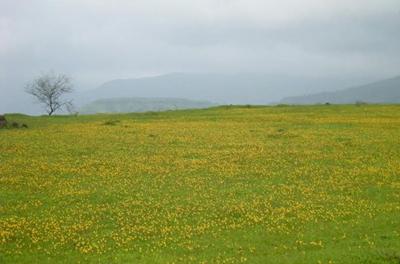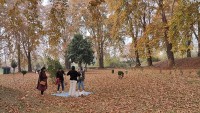 NIL
NIL
Caring for Kas
Located near Satara, Maharashtra, the Kas plateau is a unique landscape and home to many endemic flora and fauna, some of which are endangered. However, uncontrolled tourism is slowly squeezing the life out of this plateau, finds Uttara Gangopadhyay
It seemed as if anyone with a pair of functional legs and residing in and around Satara, Pune and Mumbai had arrived at Kas that September morning. People of all ages, including senior citizens with walking sticks, couples with babies in their arms, were all over the plateau.The forest guards tried their best to disperse the crowd into orderly groups, and to stop them from trampling on the flowers to take the umpteenth picture, but to little avail. The parking lot was full and the road to the plateau was choc-a-bloc with all kinds of vehicles. Even the regular visitors were surprised at this sudden surge of people.
Situated on the backyard of Satara town, the Kas plateau is a typical example of lateritic rocky outcrop (known as asada in local language). The geological nature of the plateau has given it a unique ecosystem with many endemic species of flora and fauna. For most of the year, the flora lie underground, showing up only during the monsoon, usually between August and October. Soon the entire plateau is covered in a profusion of pink, yellow, white, purple and other colours. .jpg)
As the plateau appears dry and barren to the untrained eye for the greater part of the year, most people regarded it as a waste land, where the poor herdsmen brought their cattle to graze and local louts repaired for uninterrupted boozing sessions. But in June 2012, after UNESCO tagged Kas as a World Natural Heritage Site (one of the 39 declared sites in the Western Ghat), people suddenly woke up to find a hero among their midst. A plateau that was only visited by a few biology researchers, and a handful of nature lovers and photographers during the two months of the flowering season, suddenly became a tourist attraction. Everyone wanted to see the flowers of Kas.
But it is not merely the flowering beauty that makes Kas unique. According to Aparna Watve, assistant professor at Tata Institute of Social Sciences, it is a representative of the rocky plateaus of the northern Western Ghats, an endangered habitat itself. “The place has a large number of threatened species of plants, rare animals and ecosystem processes unique to the region,” she says.
According to a report by ENVIS Center, environment department, Government of Maharashtra, Kas and the nearby Koyna area is home to about 1,500 types of plants and about 33 endangered varieties. More than 450 species of wild flowers bloom in and after monsoon season and most of them are endemic herbs. More than 850 species of flowering plants are reported from Kas plateau; out of these, 624 species have been included in the Red Data Book and 39 of those from the Red Data Book are found only in the Kas region.
Usually the cycle of flowering keeps changing as the monsoon progresses. Some of the commonly seen species include the white Habenaria (ground orchids), the bright yellow sonki, the easily distinguishable Smithia (because of its similarity with mickey mouse), insectivorous plants such as the Utricularia (Sita’s tears) and the Drosera; etc. There are some flowers, such as the Strobilanthes, which flower every seven to nine years. Besides it floral wealth, Kas is also home to several faunal species. This habitat supports diverse animals. Malabar larks, pipits and raptors such as eagles, kestrels are very frequently seen birds on the Kas plateau.
Over the past few years, Kas has weathered various threats, especially those in the name of development.According to Watve, when the road was made many of the boulders were used up, starting the disturbance, and destroying the habitat of the fauna. The activities also introduced some species from surrounding areas. But thanks to the efforts of the forest department, the plan to construct windmills and an airstrip were scrapped. “The current main threat is excessive, recreational tourism,” warns Watve.
To promote tourism in the area, many refer to Kas, wrongly though, as Maharashtra’s ‘valley of flowers’, comparing it with the Valley of Flowers in the Garhwal Himalayas, which also breaks into a profusion of blooms for a short period during the monsoon.But owing to the difficulty in reaching this region in the Himalayan foothills, the number of visitors is automatically limited. Easy accessibility has been a bane for the Kas plateau. Besides, most of the plants that grow here are very small, some so tiny that they lie hidden beneath boulders or among the green meadows. Hence, when people gather in the meadows in large numbers, they stomp on these fragile plants. Technology has made it easy to take photographs; groups of people huddling among the flowering patches do not realise the harm they cause. According to experts, more than 99 per cent of the species are herbaceous annuals that complete their life cycle during the relatively favourable monsoon period. Hence, the movement of a large number of people may not only hamper seed dispersal but also drive away the pollinators like bees and other insects, which in turn, may lead to extinction of these endemic plants.
Scientists point out that the aesthetic aspect such as laying emphasis on the beautiful flowers, keeping the place free from waste are not enough. One has to understand the serious impact in long term sustenance of the ecosystem. “We have seen what effect commercial or recreational tourism had on Panchgani. It is necessary to plan the entire management with ecosystem conservation as the goal.... the beauty is incidental or secondary in this matter,” says Watve.
Though the forest department has fenced off some of the fragile zones and have implemented rules to curb the number of people, measures are falling woefully short. According to Prerna Agarwal, who has been studying the impact of tourism on Kas and how to implement sustainable eco-tourism in the area, “Tourism has increased manifold in the past seven years. But the carrying capacity of the land is limited. Yet tourism is also providing income to the local people. So it’s necessary to bring a balance between the two.” As an immediate measure, Agarwal suggests the creation of onsite awareness for visitors. Also, “Introduction of proper signage and trained guides will go a long way in educating the people.” Yatish Lele, who has researched on Kas believes long-term management is key to saving the plateau from these aspects.
As Kas breaks into another season of colourful flowers and tourist onslaught, one wonders how long the plateau will be able to survive. Probably, the answer lies in Watve’s succinct comment, “Kas is a story in the making; it depends on citizens entirely which way they want it to go. We as scientists can point out the correct actions, but there are too few of us to influence the administration or the policy makers.”
Top Headlines
-
Environment
From Dust to Life: How Tal Chhapar Became Indias Grassland Revival Blueprint
December 18, 2025
-
Environment
From Nets to Lifelines: The Rising Whale Shark Rescue Movement Across Indias West Coast
November 29, 2025
-
Environment
Indi Setu: Wildlife on the Brink: Can We Rewild a Warming World?
October 25, 2025
-
Environment
SonaSPEED motors power NASAISRO synthetic aperture radar mission
August 01, 2025
-
Environment
How green is my city
July 01, 2025
-
Environment
India's River Dolphin: Clear And Present Danger
May 28, 2025
-
Environment
South Kashmir The costs of coexisting with predatory wildlife
May 12, 2025
-
Environment
Sariska Tiger Reserve: A maharani recognised
May 02, 2025
-
Environment
Arunachal Pradesh: Retracing a century-old biodiversity in Siang Valley
April 03, 2025
-
Environment
Toxic air and smog choke Delhi as experts at COP29 in Baku warn how dragging feet on fossil fuel reduction can cause catastrophe
November 19, 2024

